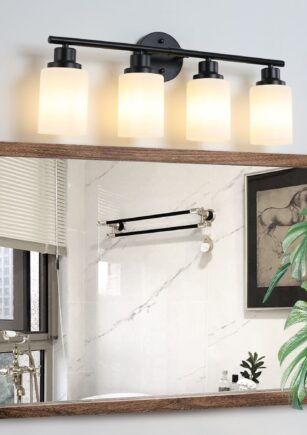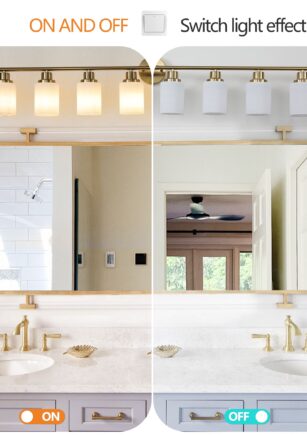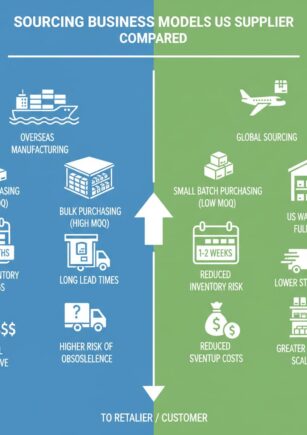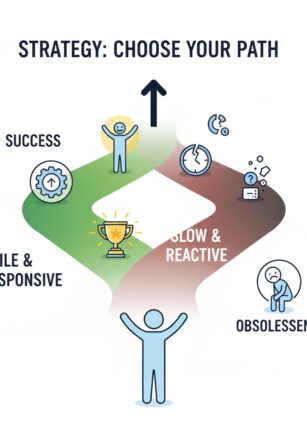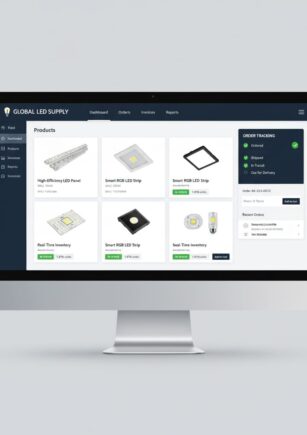The Ultimate Guide for Independent Lighting Retailers to Thrive in 2026
Running an independent lighting store is an act of passion. It’s a love for design, a commitment to quality, and a belief in the power of community. But in a world dominated by Amazon and big-box giants, passion alone isn’t enough to keep the lights on. You’re facing intense price wars, the crushing weight of inventory costs, and ever-changing trends.
So, how do you not just survive, but truly thrive? You get smarter. Faster. More agile. This is your complete playbook. We’ve distilled industry knowledge into a guide covering the four pillars of a successful modern lighting business: mastering your inventory, building a catalog that sells, deploying winning marketing tactics, and choosing the right supply partner to fuel your growth. Let’s build a brighter future for your business, starting now.
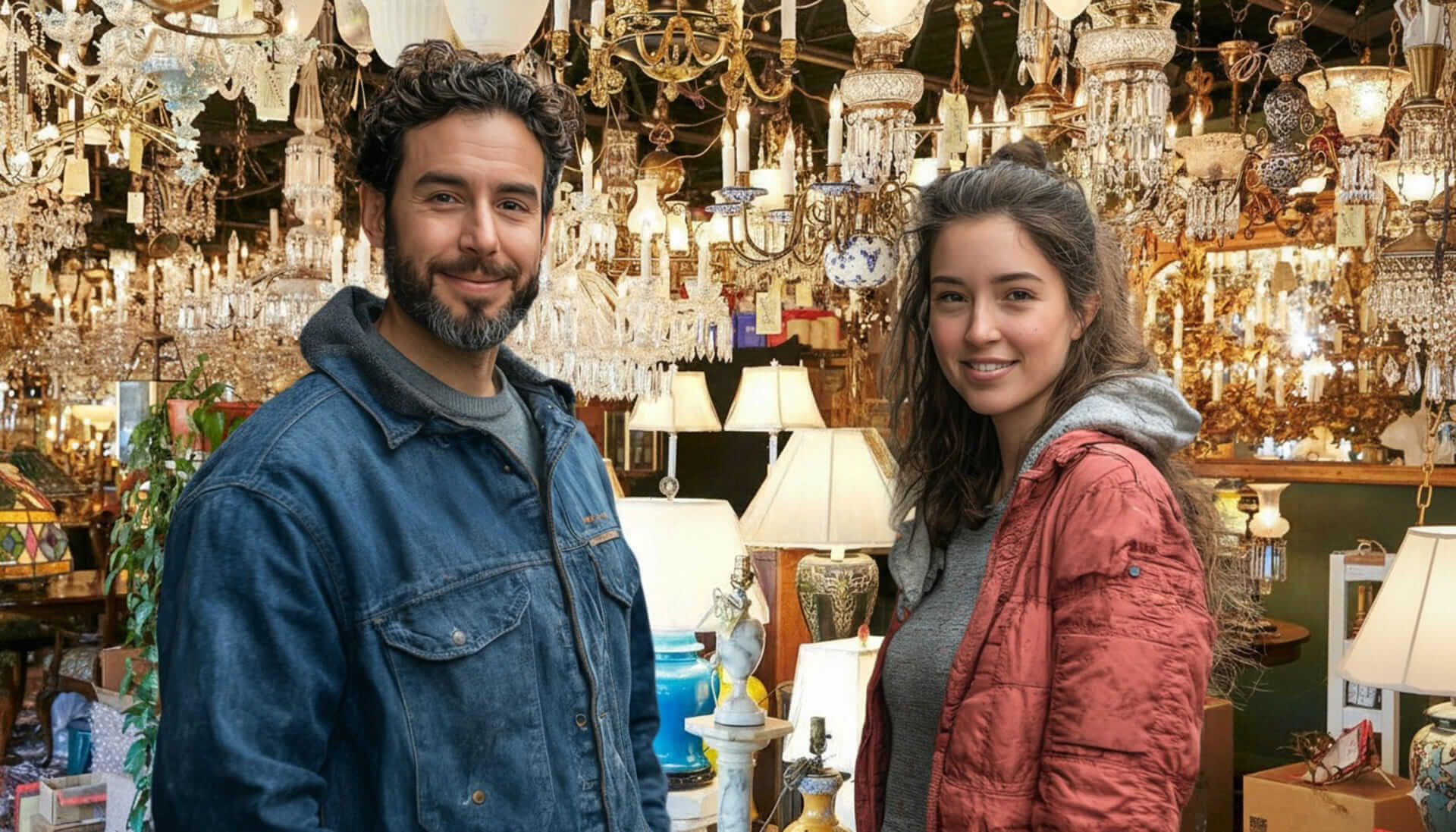
Table of Contents
Part 1: The New Rules of Inventory & Financial Management
The real magic of a profitable retail business happens behind the scenes. It’s in the numbers, the strategy, and the disciplined management of your two most critical assets: your cash and your inventory. Let’s unlock the secrets to mastering both.
1. Understanding Modern Wholesale: Why MOQ Matters
Let’s talk about three little letters that have a huge impact on your business: M-O-Q. Getting a handle on Minimum Order Quantity is the first step toward smart sourcing and financial freedom.
What is MOQ? A Breakdown for Small Retailers
Think of MOQ as a supplier’s “minimum buy-in.” It’s the smallest order they’re willing to process, whether that’s a certain number of units or a total dollar amount. Why do they do this? It’s about efficiency. For a factory, it’s far more cost-effective to produce and ship 100 lamps at once than to handle 100 separate orders for one lamp. Understanding the different types—from single-product minimums to flexible value-based orders—is your key to finding a partner who fits your small business model. For a complete glossary of terms and strategies, it’s essential to start with the fundamentals. Dive into our full guide: What is MOQ? A Small Retailer’s Guide to Minimum Order Quantities.
High MOQ vs. Low MOQ: A Strategic Comparison
This is one of the most important decisions you’ll make. Traditional importers demand high MOQs, which can get you a lower price per item but at a huge cost: your cash. A low-MOQ partner, on the other hand, gives you the flexibility to grow without the risk. Which path is right for you? Let’s break it down.
| Feature | High MOQ Model (The Old Way) | Low MOQ Model (The Smart Way) |
|---|---|---|
| Capital Investment | Very High (Ties up your cash) | Low (Keeps cash free for other needs) |
| Inventory Risk | High (Risk of unsold “dead stock”) | Very Low (Order what you need, when you need it) |
| Product Testing | Difficult & Expensive | Easy & Affordable (Test new styles with small orders) |
| Ideal For | National chains with deep pockets | Independent retailers and agile businesses |
How to Negotiate MOQ with Suppliers
You have more power than you think, even as a small business. Don’t be afraid to negotiate. You can often find flexibility by presenting a clear growth plan or offering faster payment terms. However, the most powerful negotiation tool is proposing a mixed-batch order. As the experts at Forbes suggest, finding a win-win solution is key. Meeting a supplier’s dollar-value minimum with a diverse range of products is the perfect example—they get the order size they need, and you get the product variety you want without the risk.
2. The Power of a Low-Risk Inventory Model
Cash flow is the oxygen for your business. When it’s trapped in unsold inventory sitting in your backroom, your business can’t breathe. A low-risk model is your oxygen mask, giving you the freedom to operate and grow without being weighed down.
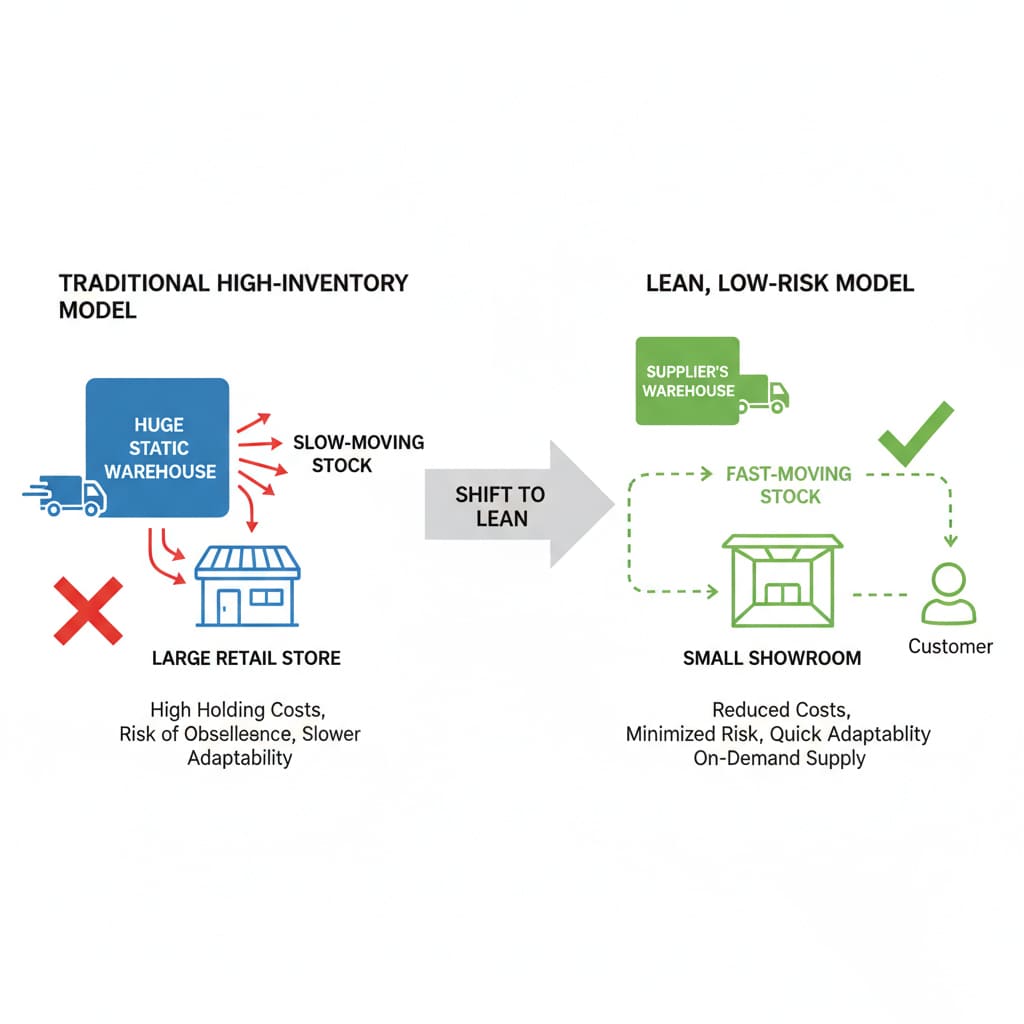
Freeing Up Your Cash Flow with a Just-in-Time Approach
Every lamp in your stockroom is a stack of cash you can’t use. A “Just-in-Time” (JIT) inspired model changes the game. By working with a supplier who holds inventory in a US warehouse, you can order products just as you need them. Imagine selling a chandelier off your floor and having its replacement ordered and on its way the same day. This lean approach keeps your money in your bank, ready to be deployed for marketing, payroll, or unexpected opportunities. Getting this right is fundamental. For a deeper dive into the numbers, read our guide on Cash Flow Management 101 for Independent Retailers.
Reducing Financial Risk with a US-Based Warehouse
A domestic warehouse is the engine of a low-risk strategy. It means replenishment takes days, not months. It means no more sleepless nights worrying about customs delays or container ships stuck at sea. This reliability allows you to operate with confidence and make promises to your customers you can actually keep. It’s the ultimate competitive advantage, allowing you to be more responsive and agile than any competitor relying on slow, international supply chains. Explore all the game-changing advantages in The Top 5 Benefits of Partnering with a Low-MOQ Lighting Supplier.
How to Calculate Your Ideal Inventory Levels
Running a lean business doesn’t mean having empty shelves; it means having the *right* products at the *right* time. You need to become a student of your own data. Your inventory turnover rate is a vital sign of your business’s health. It tells you how quickly you are converting inventory into cash. Pair this with a small “safety stock” of your bestsellers, and you’re protected from sudden demand without being over-leveraged. As the Small Business Administration advises, proper inventory management is crucial. Find the formulas and strategies to strike the perfect balance in our guide: How Much Inventory Should a Small Lighting Store *Really* Carry?
3. Eliminating Dead Stock & Maximizing Profitability
Let’s be honest. Dead stock is more than just unsold inventory. It’s a silent profit killer. It’s a constant reminder of a past buying mistake, and it’s actively costing you money every single day it sits on your shelf.
Identifying and Clearing Out Unsold Inventory
“The first step to solving any problem is recognizing there is one.”
It’s time for an inventory audit. Run a sales report for the last year. Any product with few or no sales needs to be addressed. Don’t be sentimental; be decisive. A well-marketed clearance event, a creative product bundle, or even a strategic donation for a tax write-off are all proactive solutions. The goal is to convert that stagnant asset back into cash, no matter how small, so it can be reinvested in products that will actually sell. Get our complete playbook of tactics in the guide: How to Reduce Dead Stock and Maximize Inventory Turnover.
Smart Pricing Strategies to Move Products Faster
Your price tags are powerful marketing tools. While simply doubling the wholesale cost (keystone pricing) is a common starting point, a more sophisticated strategy can significantly impact your sales and margins. Experiment with psychological price points ($99 vs. $100), tiered discounts for multiple purchases, and using a higher Manufacturer’s Suggested Retail Price (MSRP) to anchor the value before offering a compelling sale price. The right price doesn’t just make a sale; it reinforces the quality and value of your brand. Master the art and science of pricing with our Simple Guide to Pricing Strategy for Your Lighting Showroom.
The Hidden Costs of Holding onto Old Stock
The true cost of dead stock is staggering when you look beyond the initial purchase price. It’s a financial drain that includes storage costs, insurance fees, and property taxes. But the biggest cost is the opportunity cost. The thousands of dollars tied up in that outdated collection of lamps could be funding your next bestseller. Recognizing these hidden financial leaks should give you all the motivation you need to keep your inventory fresh, exciting, and, most importantly, profitable.
Part 2: Building a Catalog That Captivates & Converts
Your product catalog is your brand’s story. It’s your perspective on design and your answer to the question, “What do my customers truly want?” A winning catalog isn’t about having everything; it’s about having the right things, presented with authority and style.
4. Decoding the Hottest Lighting Trends of 2026
Your customers don’t live in a vacuum. They are constantly inspired by HGTV, Pinterest, and Instagram. Being the first in your town to stock the next big trend is what elevates your store from a simple shop to a design destination.
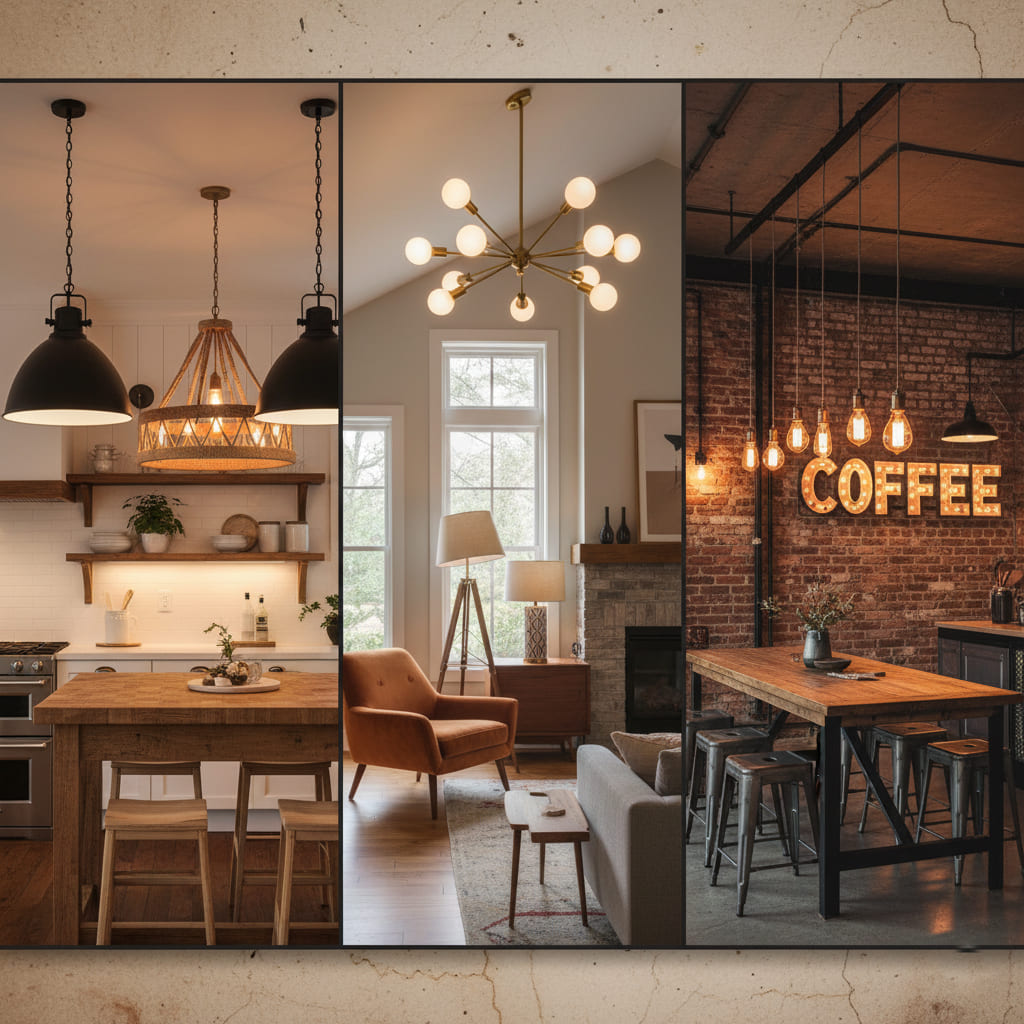
Sourcing the “Modern Farmhouse” Look Customers Love
This trend is a powerhouse for a reason: it’s warm, inviting, and effortlessly stylish. It blends rustic comfort with clean, modern lines. Think matte black or bronze finishes, natural wood tones, and simple glass shades. It’s the go-to style for kitchen and living room renovations, making it a reliable and profitable cornerstone for your inventory. Learn how to build the perfect collection: Get the Look: Sourcing Modern Farmhouse Lighting for Your Showroom.
The Enduring Appeal of Mid-Century Modern Design
Clean lines, organic shapes, and a beautiful mix of materials like brass, walnut, and glass define the timeless appeal of Mid-Century Modern (MCM). From iconic sputnik chandeliers to elegant globe pendants, these pieces are functional sculptures. Offering a well-curated selection of MCM fixtures signals to design-savvy customers and interior designers that you are a serious player. Explore the key silhouettes and designers in our Mid-Century Modern Lighting: A Retailer’s Buying Guide.
Mastering the Industrial Chic Aesthetic
Drawing inspiration from old factories and urban lofts, the industrial look is all about raw, honest materials. Think exposed Edison bulbs, aged metals, and utilitarian forms. This style is incredibly popular not just in homes, but also in commercial spaces like cafes, breweries, and boutique offices, opening up a lucrative B2B channel for your business. Find out what sells in our guide to Industrial Chic Lighting: What Your Customers Are Actually Looking For.
Leveraging Pop Culture and TV Design Trends
Never underestimate the power of television. When a hit renovation show features a specific style of pendant light over a kitchen island, you can bet that searches for that style will skyrocket. Pay attention to these cultural moments. Being able to tell a customer, “This is a very similar style to the one featured on [Popular Show],” is a powerful sales tool that connects your products to their aspirations. Learn how to turn screen time into sales: “As Seen on HGTV”: How to Leverage TV Trends in Your Showroom.
5. Essential Product Categories for Every Showroom
While trends create excitement, your business is built on a solid foundation of core product categories. Mastering these essentials ensures you have a smart solution for every customer and every room in their home.
| Category | Primary Use | Key Selling Points | Profit Potential |
|---|---|---|---|
| Kitchen Lighting | Task & Ambient | Pendants, Under-cabinet, Recessed | High (Center of home renovation) |
| Vanity Lighting | Task & Accent | Brightness (Lumens), Color Accuracy (CRI) | High (Essential, technical sale) |
| Outdoor Lighting | Security & Ambiance | Durability, Weather Rating (IP Rating) | Medium to High (Growing market) |
| Living Room Lighting | Ambient & Accent | Chandeliers, Floor Lamps, Wall Sconces | High (Design-focused purchases) |
Kitchen Lighting: The Heart of the Home (and Your Sales)
The kitchen is the command center of the modern home and the star of most renovations. A great lighting plan here is non-negotiable, and it’s your chance to shine as an expert. You need to guide customers through the three essential layers of light: ambient (general illumination), task (focused light for workspaces), and accent. Pendants over the island are often the jewelry of the kitchen, making them a crucial and profitable part of your catalog. Stay ahead of the curve with our report: What’s Hot in Kitchen Lighting? Top Trends for 2024.
Bathroom & Vanity Lighting: Where Function Meets Style
This is where your expertise truly sets you apart from a big-box store. Selling bathroom lighting isn’t just about style; it’s a technical sale about providing shadow-free, flattering illumination for daily grooming. Guiding a customer on the correct placement, brightness (lumens), and color rendering index (CRI) builds immense trust and leads to happy clients. Become the local expert with our guide: How to Choose the Best Vanity Lights for Bathroom Renovations.
Outdoor Lighting: A Growing Market for Retailers
Homeowners are extending their living spaces outdoors, creating a massive opportunity for lighting retailers. This category is about both beauty and security. You can provide solutions for everything from illuminating a garden path to lighting a covered patio for entertaining. Because these products must be durable and weather-resistant, it’s a category where quality truly matters, giving you an edge over cheap online alternatives. Tap into this profitable market: A Retailer’s Guide to Outdoor Lighting: Expanding Your Offerings.
6. The Technical Details That Build Customer Trust
Anyone can sell a pretty object. You sell solutions. Your ability to confidently explain the technical details is what transforms you from a shopkeeper into a trusted lighting consultant, justifying your premium and earning customer loyalty.
A Retailer’s Guide to Finishes: Brass vs. Matte Black and Beyond
The finish of a fixture is a critical design choice. Matte black has become the versatile “new neutral,” fitting seamlessly into almost any decor. Warm metals like brass and gold bring a touch of luxury and are essential for Mid-Century and glam styles. Brushed nickel and chrome remain timeless choices for their clean, contemporary feel. Being able to explain how these finishes coordinate with cabinet hardware, plumbing fixtures, and paint colors is an invaluable service. Deepen your design vocabulary with our guide: Brass vs. Matte Black: Choosing the Right Finishes for Your Lighting Inventory.
Explaining Color Temperature (Kelvins) in Simple Terms
This is one of the easiest ways to demonstrate your expertise. Break down color temperature in a way anyone can understand:
- Warm & Cozy (2700K): “Think of the warm glow of a traditional incandescent bulb. Perfect for bedrooms and living rooms.”
- Bright & Neutral (3000K-3500K): “A clean, crisp light that’s great for kitchens and bathrooms where you need to see clearly.”
- Cool & Alert (4000K-5000K): “This is like bright daylight. It’s energizing and ideal for garages, home offices, and workspaces.”
Guiding a customer to the right “mood” for their room is a service they won’t forget. Master this essential conversation with our guide: Understanding Color Temperature (Kelvins): What Your Customers Need to Know.
The Importance of Safety Certifications (UL & ETL)
This is non-negotiable. Selling uncertified lighting fixtures in the US is not only irresponsible but also a massive legal liability for your business. The UL and ETL marks are a sign that a product has been rigorously tested for safety by a Nationally Recognized Testing Laboratory. Highlighting these certifications to your customers is a powerful way to communicate your commitment to quality and safety, providing peace of mind that cheap online marketplaces simply can’t offer. As the leading industry group, the American Lighting Association emphasizes the importance of these standards. Make sure your business and your customers are protected: Understanding UL and ETL Certifications: A Must-Know for US Lighting Retailers.
Part 3: Marketing & Sales Strategies for the Modern Retailer
You’ve built a solid foundation with smart inventory and a winning catalog. Now, it’s time to shout it from the rooftops. Modern marketing for a local business isn’t about having the biggest budget; it’s about being more clever, more personal, and more connected to your community.
7. Winning the Battle Against Big-Box Stores
Let’s be clear: you will never out-price or out-stock the giants. And you don’t have to. Your path to victory is to compete where they can’t: in expertise, personalization, and genuine human connection.
Identifying Your Unique Value Proposition
What is the one thing you offer that no one else can? Is it your award-winning design sense? Your exclusive collection from a local artisan? Your white-glove installation service? Whatever it is, that is your story. Define it, refine it, and then build your entire marketing message around it. This isn’t just what you sell; it’s why customers should choose to buy it from *you*.
Creating an Unforgettable In-Store Customer Experience
“People will forget what you said, people will forget what you did, but people will never forget how you made them feel.” – Maya Angelou
Your showroom is your stage. It’s where you create an experience that a website click can never replicate. Create beautiful, realistic room vignettes. Encourage customers to touch and feel the quality of the fixtures. Most importantly, train your team to be consultants, not clerks. Greet every person warmly, ask insightful questions about their project, and offer solutions, not just products. This is how you turn shoppers into lifelong clients. Find more inspiration here: How to Create an Unforgettable In-Store Customer Experience.
5 Actionable Strategies to Outsmart the Giants
Ready to go on the offensive? Host a free “How to Choose the Perfect Kitchen Lighting” workshop. Create a loyalty program for local interior designers. Offer in-home design consultations. Partner with a local high-end furniture store for cross-promotions. These high-touch, community-focused strategies build deep roots and a loyal following that the corporate giants can only dream of. Get the full playbook of tactics in our guide: 5 Ways for Small Lighting Stores to Compete with Amazon and Home Depot.
8. Mastering Local Digital Marketing
In today’s world, your physical store needs a powerful digital front door. Local digital marketing is how you ensure that when someone in your community searches for “lighting store near me,” your name is the first one they see.
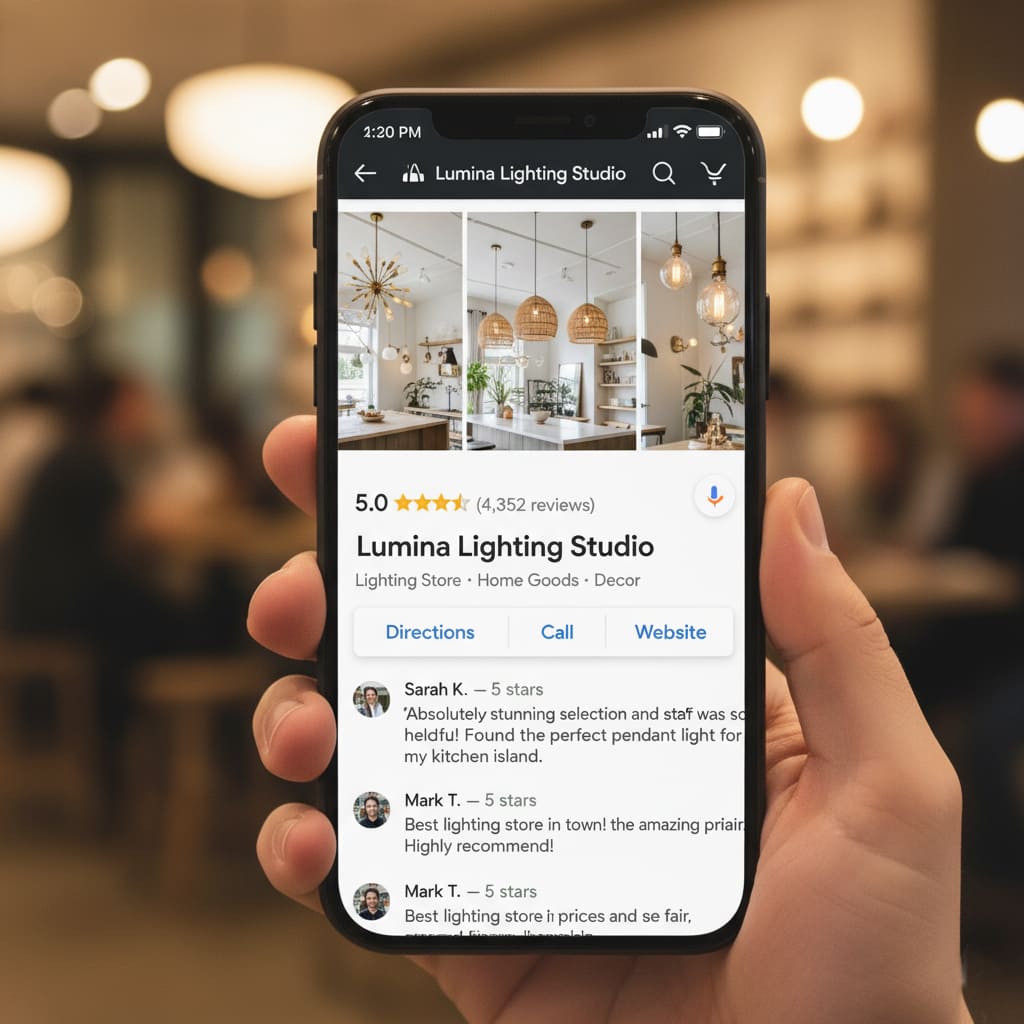
Getting Your Store on the First Page of Google Maps
For a local business, your Google Business Profile is your most important digital asset. It’s free, powerful, and often the first interaction a potential customer has with your brand. Take the time to fully optimize it: upload at least 20 high-quality photos of your showroom and products, ensure every detail is accurate, and actively encourage your happy customers to leave reviews. Responding to every single review—good or bad—shows that you are an engaged and caring business owner. Follow our complete, step-by-step checklist: Local SEO for Lighting Retailers: How to Get Found on Google Maps.
Using Instagram to Drive Foot Traffic to Your Showroom
Lighting is made for Instagram. It’s visual, transformative, and beautiful. Use this to your advantage. Post stunning photos and videos of your products, especially installed in real homes (always ask for permission!). Create captivating “before and after” Reels. Use local hashtags (#ChicagoDesigner, #MiamiHomes) to connect with your community. Think of your Instagram feed as a living portfolio that inspires people to visit your showroom and see the magic in person. Learn the secrets to creating a feed that sells: Instagram Marketing for Lighting Stores: A Visual Guide to Getting More Customers.
To Sell Online or Not? Weighing the Pros and Cons
Launching a full e-commerce operation is a massive undertaking. It requires a significant financial investment, adds logistical complexity, and puts you in direct competition with huge online players. For many small showrooms, a smarter approach is to use your website as a powerful “digital catalog.” Showcase your products beautifully, tell your story, and focus every button and call-to-action on one goal: driving customers to your physical store, where you can provide the expert service that truly sets you apart. Make the right decision for your business with our in-depth analysis: Should Your Small Lighting Store Sell Online? Pros and Cons.
9. Building a Powerful Professional Network
Your most profitable customers often aren’t individuals, but other professionals. Building a strong B2B network of designers, builders, and electricians can create a reliable and lucrative stream of repeat business.
| Professional Group | Their Need | How You Can Help | Your Benefit |
|---|---|---|---|
| Interior Designers | Unique products, reliability, trade pricing | Offer exclusive previews, a trade discount, and fast sourcing | High-value, multi-item projects |
| Builders & Contractors | Durable products, in-stock availability, speed | Stock builder packs, offer quick pickup, be reliable | Volume orders and repeat business |
| Electricians | Technical compatibility, easy installation | Provide spec sheets, ensure products are certified | Constant stream of referrals |
How to Become the Go-To Supplier for Interior Designers
Designers are your gateway to high-end projects. To earn their loyalty, you must make their job easier. Offer a generous trade discount, create a dedicated point of contact for them, and become an invaluable resource who can quickly find the perfect fixture for their vision. When you prove you are reliable and knowledgeable, you become an essential part of their team. Learn how to forge these crucial alliances: How to Build Strong Relationships with Local Interior Designers and Contractors.
Partnering with Local Builders and Electricians
These trade professionals are on the front lines, making crucial recommendations on job sites every day. Build genuine relationships with them. Offer a small referral fee, host an occasional “Contractor’s Breakfast” at your showroom, and always be the easy, no-hassle choice when they need quality products in a hurry. A little goodwill can lead to a massive amount of business.
Leveraging Your Local Chamber of Commerce
Don’t underestimate the power of old-fashioned networking. Joining your local Chamber of Commerce or a similar business group instantly connects you with the key players in your community’s economy. It signals that you are a serious, invested member of the local business ecosystem and can lead to powerful partnerships you never expected.
10. Advanced Sales Techniques for Your Team
A great salesperson doesn’t just process a transaction; they maximize its value for both the customer and the business. Training your team in these simple techniques can dramatically increase your average sale amount and customer satisfaction.
The Art of the Upsell: Increasing Average Order Value
Upselling is not about being pushy. It’s about passion and expertise. It’s about genuinely believing that a slightly more expensive product offers a significantly better solution for the customer—whether that’s superior light quality, a longer warranty, or a more impactful design. When you frame it as providing a better outcome, customers appreciate the recommendation.
Cross-Selling: From a Single Lamp to a Whole-Room Solution
Great salespeople think in projects, not products. The customer who needs a new dining room chandelier also needs a dimmer switch. They might benefit from matching wall sconces or a new lamp for the sideboard. By asking thoughtful questions about their entire space, you can identify additional needs and provide a more complete solution, which is better for them and more profitable for you. Equip your team with the right scripts and strategies: Upselling and Cross-Selling Techniques for Your Lighting Showroom Staff.
Handling Common Customer Objections
Prepare for the inevitable “I found it cheaper online” objection. Train your team to respond with confidence, not defensiveness. Acknowledge the price, then pivot to the immense value you provide: certified safety, expert guidance, a no-hassle return policy, support for a local business, and the peace of mind that comes from seeing and touching the product before buying. You’re not just selling a light; you’re selling a guarantee.
Part 4: The Ultimate Guide to Supplier Partnerships
This may be the final section, but it’s the most important. You can do everything else right, but if your supply chain is broken, your business will eventually fail. Your supplier isn’t just a vendor; they are your most critical partner. Choosing the right one is the foundation of your success.
11. How to Vet and Choose the Perfect Wholesale Partner
In a world of endless options, a rigorous vetting process is your shield. It protects your business, your reputation, and your peace of mind from unreliable partners who can cost you dearly in the long run.
| Key Vetting Area | What to Look For (Green Flags ✅) | What to Avoid (Red Flags 🚩) |
|---|---|---|
| Communication | Clear, prompt, professional responses. A dedicated account rep. | Vague answers, slow response times, no phone number. |
| Quality Control | Clear documentation of QC process. Safety certifications (UL/ETL). | No mention of safety standards. Prices seem “too good to be true.” |
| Logistics | A US-based warehouse. Clear shipping times and costs. | Ships only from overseas. Unclear shipping policies. |
| Business Model | Low MOQ options. Support for independent retailers. | High, inflexible MOQs. Primarily serves giant retailers. |
The 7 Critical Questions Every Retailer Must Ask a Potential Supplier
Before you commit a single dollar, you need straight answers. Ask about their quality control process on the factory floor. Ask about their real-world shipping times from their US warehouse. Ask how they handle damages and defects. A great partner will welcome these questions and have confident, transparent answers. Arm yourself with this essential checklist: How to Vet a Wholesale Lighting Supplier: 7 Critical Questions to Ask.
Understanding a Supplier’s Return and Warranty Policies
A supplier’s return policy is a direct reflection of how much they believe in their own products. A difficult, confusing, or non-existent policy is a massive red flag. You need a partner who makes the process simple and fair when a product inevitably arrives damaged or fails prematurely. This protects your bottom line and allows you to offer better service to your own customers. Don’t sign a contract until you’ve read this: Why Your Supplier’s Return Policy Matters for Your Bottom Line.
Red Flags to Watch Out for When Sourcing
Trust your instincts. If a potential partner has an unprofessional website, avoids answering direct questions, or pressures you into a large first order, it’s time to walk away. The sourcing landscape is filled with options; there is no reason to settle for a partner who doesn’t meet the highest standards of professionalism and transparency.
12. The Domestic vs. International Sourcing Decision
This is the fundamental choice that will define your business model. Will you take on the immense risk and complexity of direct international sourcing, or will you leverage the speed and simplicity of a domestic supply partner?
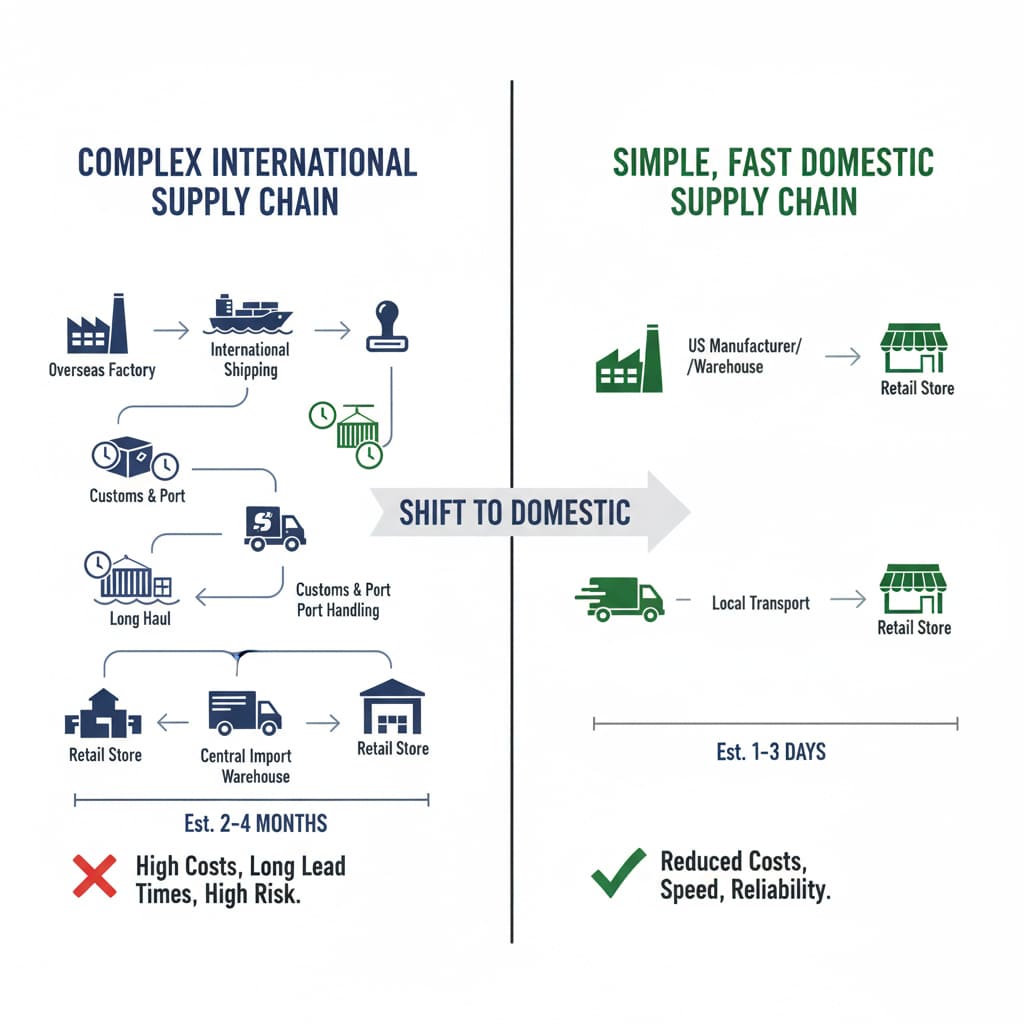
A Head-to-Head Comparison: Pros and Cons
The allure of a rock-bottom unit price from an overseas factory is strong, but it comes with a mountain of challenges: huge MOQs, 3-6 month lead times, logistical nightmares, and cultural communication barriers. A domestic supplier offers speed, flexibility, and simplicity, allowing you to operate a leaner, more agile, and ultimately more profitable business. See a detailed breakdown of every factor in our head-to-head analysis: Domestic vs. International Lighting Suppliers: A Head-to-Head Comparison.
The Game-Changing Advantage of a US-Based Warehouse
This hybrid model is the future of retail sourcing. It gives you the best of both worlds: the cost efficiencies of global manufacturing combined with the speed and reliability of local distribution. A supplier with a well-stocked US warehouse is a strategic weapon. It allows you to replenish your inventory in days, respond instantly to market trends, and provide a level of service that your internationally-sourced competitors simply can’t match. This is the core of the modern retail supply chain: The Importance of a US-Based Warehouse for Fast Replenishment.
Navigating the Hidden Costs and Risks of Direct Importing
The price on the factory’s invoice is just the tip of the iceberg. Direct importing involves a cascade of additional costs: international freight, insurance, customs brokerage fees, import tariffs, and port transportation fees. There’s also the massive risk of receiving a container full of defective products with little to no recourse. These hidden factors can quickly erase any perceived savings and turn a “great deal” into a financial disaster. Before you even think about wiring money overseas, read our essential guide: Navigating the Hidden Costs and Risks of Direct Importing.
Conclusion: Your Path to a Thriving Business
Thriving as an independent lighting retailer today isn’t about having the most inventory or the biggest showroom. It’s about being smarter, faster, and more connected than your competition. It’s about building a resilient business founded on intelligent financial management, a keen eye for design, savvy marketing, and—above all—a strategic partnership with a supplier who is genuinely invested in your success.
You have the passion. You have the local expertise. By implementing the strategies in this guide, you can build a powerful, profitable business that becomes a cherished and indispensable resource in your community.
Ready to Elevate Your Business?
Register today to get full access to our catalog, view prices, and enjoy fast, reliable shipping from our U.S. warehouse.
Our Articles
More About Lighting

